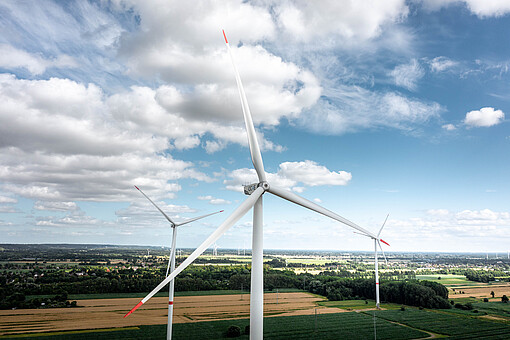Curslack Research Wind Farm

Wind — the energy of the future.
Located roughly one kilometre from the Energy Campus Technology Centre, the Curslack wind farm is home to five wind turbines in the 2.40 to 3.15 megawatt class. The facility is able to provide up to 11,000 two-person households with energy each year.
The integrated network consisting of the research facilities and the wind farm enables numerous research projects and synergies. Some examples include the integration of wind energy into the energy supply network and the compensation of fluctuations through demand management and storage components. A local lithium-ion battery was installed at the wind farm for this purpose.* This makes it possible to compensate for fluctuations in the grid using balancing energy.
The research wind farm is outfitted with a condition monitoring system. Numerous sensors monitor the state of the wind turbines, enabling early recognition of errors, the efficient management of wind farm operations and an increase in energy production.
A 120-metre-high wind measurement mast that complies with current IEC norms is located directly next to the wind farm. Anemometers, wind vanes and other sensors located at different heights make it possible to determine conditions in the area, including wind speed and direction. LiDAR systems (wind measurement using laser beams) are used to measure wind-shadow turbulence and wind-shadow conditions, as well as wind profile and performance curves. Two LiDAR systems built onto the turbines and one terrestrial LiDAR are available for this purpose.
For research on the risk of collisions with bats, radar equipment is in continuous use at the Curslack Wind Farm in order to record the presence of bats on a large scale. Acoustic recording equipment has also been installed in the gondolas to identify which species are present and to what extent. The simultaneous use of these devices and the correlation of the data is intended to lead to the development of a spatial recording system that can be used in future to validate existing shutdown algorithms for wind turbines.
* Because the research project has now been completed, the battery storage system provided by the project partner has been dismantled. The infrastructure and subcomponents remain on site and follow-up projects are planned.
Laboratory head
Sven Störtenbecker
T +49.40.428 75-5767
